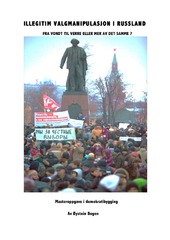| dc.contributor.author | Bogen, Øystein | eng |
| dc.date.accessioned | 2014-07-31T15:24:15Z | |
| dc.date.available | 2014-07-31T15:24:15Z | |
| dc.date.issued | 2014-05-05 | eng |
| dc.date.submitted | 2014-05-05 | eng |
| dc.identifier.uri | https://hdl.handle.net/1956/8227 | |
| dc.description.abstract | Det russiske parlamentsvalget i 2011 var det mest omstridte i landet i nyere tid. Titusener tok til gatene for å kreve omvalg, etter en valgprosess som i følge opposisjonen var den skitneste noen sinne. I denne avhandlingen ettergår jeg denne påstaden. En kvantitativ innholdsanalyse av nasjonale og internasjonale valgobservasjonsrapporter fra de russiske parlamentsvalgene i 2007 og 2011 viser at illegitim valgmanipulasjon økte i omfang i 2011 i forhold til 2007. Samtidig viser resultatene av denne analysen at valgmanipulasjonen endret karakter mellom de to valgene. I 2007 ble det i større grad manipulert på et systemisk nivå, og før selve valgdagen. I 2011 viser denne analysen, fant valgmanipulasjonen i større grad sted på selv valgdagen, og på et tilsynelatende mer teknisk nivå. To forklaringsmodeller kan bidra til å kaste lys over disse resultatene: En sentrifugal modell, der sentrale myndigheter beodret jukset, som en markering av styrke overfor opposisjonen; og en sentripetal modell, der lokale myndigheter, under stadig større økonomisk og politisk press fra sentralt hold, på eget initiativ manipulerte stemmegivning og resultater. | en_US |
| dc.description.abstract | The Russian parliamentary elections of 2011 were the most controversial elections in modern Russian history. Thousands of Russians took the streets to protest what the opposition dubbed "the dirtiest elections ever". The main aim of this project was to check the veracity of that claim. This quantitative content analysis of both national and international election monitoring reports shows that the 2011 elections were indeed subject to more illegitimate manipulation than in 2007. It also indicates that the nature of the cheating changed, from a systemic level, to a more technical level, on election day itself in 2011. Two models have been developed to explain possible mechanisms behind this development: A centrifugal mechanism, where central elites are the masterminds behind the cheating in order to show strength and impunity towards the political opposition; and a centripetal mechanism, wherein regional authorities, under increasing economical and political pressure from the center initiated and exercised the electoral manipulation. | en_US |
| dc.format.extent | 1417261 bytes | eng |
| dc.format.mimetype | application/pdf | eng |
| dc.language.iso | nob | eng |
| dc.publisher | The University of Bergen | eng |
| dc.subject | Russland | eng |
| dc.subject | Demokrati | eng |
| dc.subject | valg | eng |
| dc.title | Illegitim valgmanipulasjon i Russland. Fra vondt til verre eller mer av det samme? | eng |
| dc.type | Master thesis | en_US |
| dc.rights.holder | Copyright the author. All rights reserved | en_US |
| dc.description.degree | Master i Erfaringsbasert master i demokratibygging | |
| dc.description.localcode | SAMPOL650 | |
| dc.description.localcode | MASV-DEMOK | |
| dc.subject.nus | 731112 | eng |
| fs.subjectcode | SAMPOL650 | |
